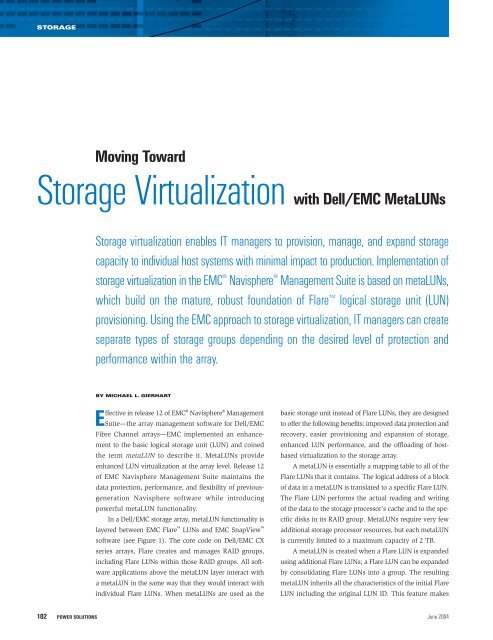STORAGEMoving TowardStorage Virtualization with <strong>Dell</strong>/EMC MetaLUNsStorage virtualization enables IT managers to provision, manage, and expand storagecapacity to individual host systems with minimal impact to production. Implementation ofstorage virtualization in the EMC Navisphere Management Suite is based on metaLUNs,which build on the mature, robust foundation of Flare logical storage unit (LUN)provisioning. Using the EMC approach to storage virtualization, IT managers can createseparate types of storage groups depending on the desired level of protection andperformance within the array.BY MICHAEL L. GIERHARTEffective in release 12 of EMC ® Navisphere ® ManagementSuite—the array management software for <strong>Dell</strong>/EMCFibre Channel arrays—EMC implemented an enhancementto the basic logical storage unit (LUN) and coinedthe term metaLUN to describe it. MetaLUNs provideenhanced LUN virtualization at the array level. Release 12of EMC Navisphere Management Suite maintains thedata protection, performance, and flexibility of previousgenerationNavisphere software while introducingpowerful metaLUN functionality.In a <strong>Dell</strong>/EMC storage array, metaLUN functionality islayered between EMC Flare LUNs and EMC SnapView software (see Figure 1). The core code on <strong>Dell</strong>/EMC CXseries arrays, Flare creates and manages RAID groups,including Flare LUNs within those RAID groups. All softwareapplications above the metaLUN layer interact witha metaLUN in the same way that they would interact withindividual Flare LUNs. When metaLUNs are used as thebasic storage unit instead of Flare LUNs, they are designedto offer the following benefits: improved data protection andrecovery, easier provisioning and expansion of storage,enhanced LUN performance, and the offloading of hostbasedvirtualization to the storage array.A metaLUN is essentially a mapping table to all of theFlare LUNs that it contains. The logical address of a blockof data in a metaLUN is translated to a specific Flare LUN.The Flare LUN performs the actual reading and writingof the data to the storage processor’s cache and to the specificdisks in its RAID group. MetaLUNs require very fewadditional storage processor resources, but each metaLUNis currently limited to a maximum capacity of 2 TB.A metaLUN is created when a Flare LUN is expandedusing additional Flare LUNs; a Flare LUN can be expandedby consolidating Flare LUNs into a group. The resultingmetaLUN inherits all the characteristics of the initial FlareLUN including the original LUN ID. This feature makes102POWER SOLUTIONS June 2004
STORAGEmetaLUN creation transparent to the attached host server. The initialFlare LUN that is converted is known as the base LUN. All FlareLUNs that are added to a metaLUN conform to the characteristicsof the base LUN.Structuring metaLUNs for performance or capacityThree methods of structuring metaLUNs exist: striping, concatenation,or a combination of both. A metaLUN structure comprisesone or more components, and each component can contain one ormore Flare LUNs. Depending on the CX series array, up to 16 componentscan be used in a metaLUN, and each component can holdup to 32 Flare LUNs. The striping of data is performed within acomponent, while concatenation is the process of adding morecomponents to the metaLUN.A striped metaLUN is designed to enhance performance byaggregating the throughput, measured in I/Os per second (IOPS),and bandwidth, measured in megabytes per second (MB/sec), ofthe underlying Flare LUNs contained in the stripe. Expansion of ametaLUN through striping is designed to increase both the performanceand capacity of the metaLUN.Implementing a striped expansion takes time, but once thestriped expansion is initiated, it occurs in the background and is functionallytransparent to the attached host server. Expansion rates canbe set to low (4 GB per hour), medium (6 GB per hour), high(12 GB per hour), or ASAP. Thedefault setting is high. TheASAP setting is designed todevote all of the array’s storageprocessor resources to theexpansion process, and thereforeis not recommended ina production environment.When administrators implementstriping within a component,all Flare LUNs used inthat component must be identicalin capacity, RAID type,and drive type (either FibreChannel or ATA disks).Before the introduction ofmetaLUNs, host-based LUN virtualizationwas required toachieve higher performancefrom an array than was possiblefrom a single Flare LUN.On Microsoft ® Windows ® operatingsystem–based hosts, basicHost I/OEMC SAN Copy EMC MirrorView EMC SnapViewMetaLUNFlare LUNStorage processor cacheRAID groupDisksFigure 1. MetaLUN functionality in the storage arraydisks were converted to dynamicdisks, allowing multiple LUNs tobe collected into a dynamic, orstriped, volume designed to provideeither performance orcapacity improvements. However,dynamic disks can be usedonly by nonclustered servers;Microsoft Cluster Service (MSCS)requires that all volumes in a clusterbe basic disks, not dynamicdisks—a restriction that limitsthe size, scalability, and performanceof clustered hosts. ByImplementing a stripedexpansion takes time, butonce the striped expansionis initiated, it occurs inthe background and isfunctionally transparent tothe attached host server.moving virtualization from the host to the <strong>Dell</strong>/EMC array, a highperformancemetaLUN can be created and partitioned by the hostas a basic disk.<strong>Dell</strong>/EMC CX400 and CX600 storage arrays and the new CX500storage array have two back-end 2 Gbps Fibre Channel arbitratedloops per storage processor. The new CX700 has four back-end2 Gbps Fibre Channel arbitrated loops per storage processor. Astriped metaLUN spanning multiple back-end loops is designed toprovide superior performance to a host when compared to a simpleFlare LUN on a single back-end loop. 1 The dynamic load-balancingfeatures of EMC <strong>Power</strong>Path ® software are designed to enable highperformanceaccess between multiple host bus adapters (HBAs) inthe host and the <strong>Dell</strong>/EMC storage array.A concatenated metaLUN is designed to provide real-time capacityexpansion. When administrators create a concatenated metaLUN,all Flare LUNs must be configured as either protected storage or nonprotectedstorage, and have the same drive type. Protected storageis derived from storage groups that use RAID-1, RAID-3, RAID-5,or RAID-10 levels. Nonprotected storage is derived from storagegroups that use RAID-0 or single disks.Concatenation is designed to provide immediate availability ofadditional capacity. A best-practices recommendation is to use thesame RAID type and total number of spindles in each concatenatedcomponent of a metaLUN to help provide balanced, consistent performanceacross the entire metaLUN.Simplifying RAID group creation and provisioningBefore Navisphere release 12, Flare LUNs were created in twoways. Multiple, small-capacity Flare LUNs could be created inone RAID group; or, a large-capacity Flare LUN could be createdas a single-LUN RAID group. Properly creating a single-LUNRAID group for individual applications can be complex and canaffect overall performance depending on the RAID type used.1 For more information on metaLUN performance considerations, visit https://powerlink.emc.com/HighFreq/folder_0/H519.3_clariion_fibre_chnl_dev_ldv.pdf.www.dell.com/powersolutions POWER SOLUTIONS 103








